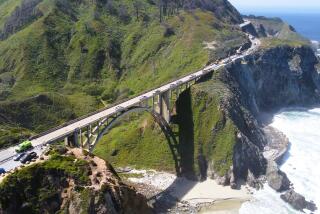Rerouting Job Could Force Temporary Shutdown : Alaska Pipeline May Face Closure
Crewmen working to reroute a portion of the Trans Alaska Pipeline have thus far been unable to seal off the section where a bypass line is being installed and may have to shut down the main line temporarily, officials said Tuesday.
John Ratterman, a spokesman for the Alyeska Pipeline Service Co., operator of the 800-mile pipeline, said a decision will be made in the next few days on what will be done to cut off the flow of oil through the potentially hazardous section. The section has sunk about 15 feet from its original level, and officials are concerned that further settling could cause the line to rupture.
The line carries 1.6 million barrels of crude oil a day from the Prudhoe Bay oil fields on the North Slope to a shipping terminal at Valdez, 800 miles to the south. It runs above ground over much of the route but is buried in sections where it crosses rivers or flood plains. The latest settling of the buried line is the 10th such incident--and the most serious--since the line began carrying oil in mid-1977, officials said.
Alyeska manages the pipeline for the consortium of oil companies that produces oil on the North Slope. The pipeline owners are Atlantic Richfield Co., Exxon Corp., Amerada Hess Corp., Mobil Corp., Phillips Petroleum Co., Unocal Corp., British Petroleum Corp., and Standard Oil Co. (Ohio), which is 55% owned by British Petroleum Corp.
A temporary camp of 200 workmen has been set up at the site, located roughly 200 miles south of Prudhoe Bay where the line crosses under the flood plain of the Dietrich River. The workers installed a temporary bypass line around the damaged section and plan to build a permanent detour above ground that will go around the flood plain. The project, scheduled to be completed in mid-1985, is expected to cost $20 million, officials said.
Ratterman said the pipeline settled because heat from the oil melted the frozen ground water table under the soil that the pipeline was resting on, about 9 feet below the ground. He said the “ice lens” had not been detected when the line was built. The line will be moved about 200 feet to the east with a new section about a half-mile long that circles the river flood plain.
He said workers tried to install a temporary bypass line a few days ago but that they were unable to completely seal off the damaged section of the pipeline.
Arlan Kohl, chief of the Department of Interior’s pipeline monitoring office in Anchorage, said Alyeska is considering shutting down the pipeline so the section can be properly sealed off.
Randy Rogers, executive director of the Northern Alaska Environmental Center in Fairbanks, said his organization is satisfied that Alyeska is taking the proper precautions to repair the line without causing environmental damage.
“It’s real encouraging that Alyeska has good enough monitoring facilities to recognize a problem like this before it ever results in a spill,” Rogers said. “We’re real happy to see that they caught it in time.”
More to Read
Sign up for Essential California
The most important California stories and recommendations in your inbox every morning.
You may occasionally receive promotional content from the Los Angeles Times.










